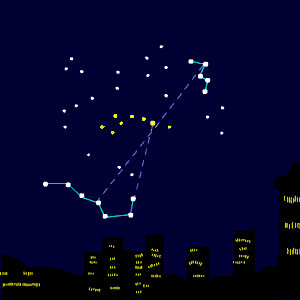- Luke

- Jun 23, 2021
- 4 min read
You made it to summer! June 21st 2021 is the first day of summer and you can tell by using the "summer triangle". Rising in the east at sunset there are three distinctly bright stars (Vega, Altair, and Deneb) which make up the summer triangle. This triangle has been a seasonal indicator for centuries in the northern hemisphere; when you see this triangle rising in the east you can know it’s summer time. Here we are at the start of summer and sure enough the summer triangle is right on the eastern horizon at sunset!

Earth has two solstices and two equinoxes, and June 21st 2021 was "summer solstice" the longest day of the year (in the northern hemisphere). This is also the day that the sun is highest in the sky (in the northern hemisphere). Because the Earth's daily rotation around its axis is tilted from the yearly rotation around the sun there’s times where the sun is directly above the equator (equinox) and times the sun is above the tropic of Capricorn/tropic of Cancer (solstices). Jun 21st the sun was above the tropic of cancer making it the summer solstice in the northern hemisphere and the winter solstice in the southern hemisphere.

Solstice is used to officially denote the start of summer and has been used for centuries. Stonehenge was used to measure the sunrise/set at the extreme points in the sky to mark solstices. You can do this at home stand in a easy to remember place like the center of your patio and watch the sun set over the next month or so. The first time you look take note of where and when the sun sets. you can do this by placing something like a rock/bottle out on the edge of your patio where you see it set or just take note of what distant trees/mountains/landmarks it sets behind. Check back a month or two later (standing in the exact same location you started with) and you should see the Sun setting slightly south of where it set during your first observation. If you keep laying out stones marking where the sun sets all year you'll eventually have made your own stone hinge from your observations (if you can check back on September 22nd that will mark fall equinox).

The ancient Egyptians used the second brightest star in the sky (only second to the Sun) Sirius to denote the start of summer. When Sirius is seen rising in the morning with the sun (as it is now) it was the hottest days and coincided with the flooding of the Nile. On occasion you might hear hot days referred to as “dog days” this actually comes from Sirius the “dog” star and dates back to ancient Egypt. It was thought that the Sun and Sirius (the two brightest stars in the sky) shining together is what made the days so hot. Because Sirius is in the constellation Canis major, the “big dog” in the sky it was natural to call hot days “dog days”. It's been hypothesizes that the "ventilation" chambers of the great pyramid in Giza were actually designed to line up with the position of Sirius. The Egyptians could have used this to make astronomical observations, much like Stonehenge was used with the sun.

Another seasonal indicator is the Big Dipper/North Star. If you're above ~35 deg latitude (as we are in Colorado) you can see the big dipper year round in your northern sky. The North Star is fairly easy to locate using the Big Dipper with the two stars at the end of the vessel of the dipper pointing right at it (see pictures below). The Big Dipper always points to the north star, like a spoke of a bike tire rotating around the north star once a year. You can use this yearly rotation to get an idea of what time of the year you’re in. Most basically if the Big Dipper is to the West of the North Star it’ll be hot (summer) and East of the North Star it’ll be cold (winter). You can further divide it by using if the Big Dipper is above the North Star at sunset it’s Spring and below the North Star at sunset means it’s fall.
My personal favorite seasonal indicator is Orion vs Scorpio. The story is that Orion has a restraining order on Scorpio. Scorpio is responsible for Orion’s death so when the gods were placing the constellations in the sky Orion made it clear he didn’t want to be anywhere near Scorpio so they placed them on opposite sides of the sky. Because they are on opposite sides of the sky, Orion is only seen in the winter night sky and Scorpio is only seen in the Summer. I can use this to see when I have skiers/people most familiar with the winter sky on the tour in the summer because they’ll ask “where’s Orion? I always see Orion”. This was also seen in the southern hemisphere there’s an Australian Aboriginal song called the “Maysong” the gist of the song is that when “the hunter” (Orion) goes to sleep and the “scorpion” (Scorpio) rises in the east that’s the best time to go salmon fishing. The song is called the Maysong because it’s describing what happens in the sky in the month of May when we transition from having Orion in the sky to having Scorpio.
If you want to learn more star lore and get an up close look at these seasonal indicators book an Astro Tour today

.png)









